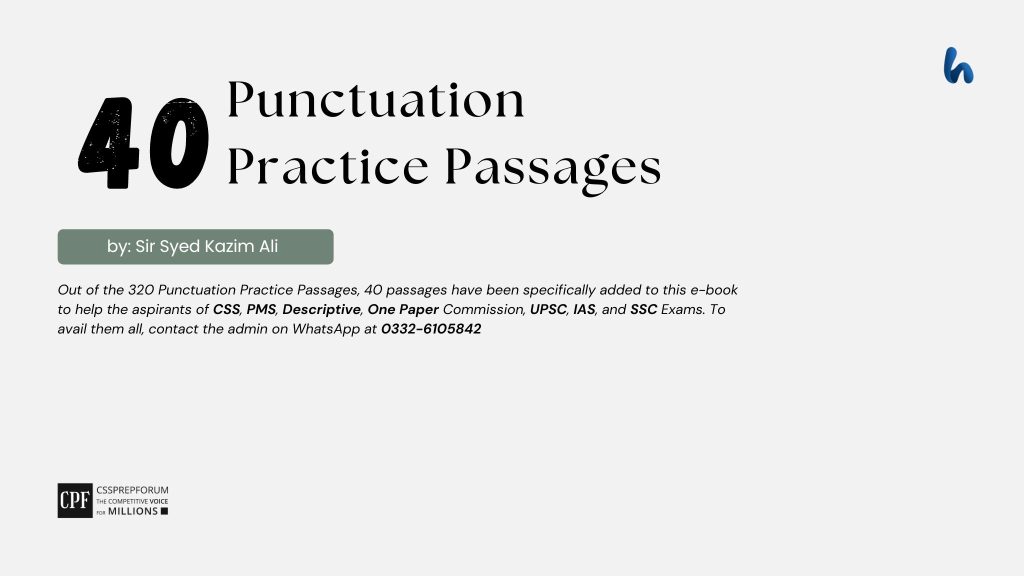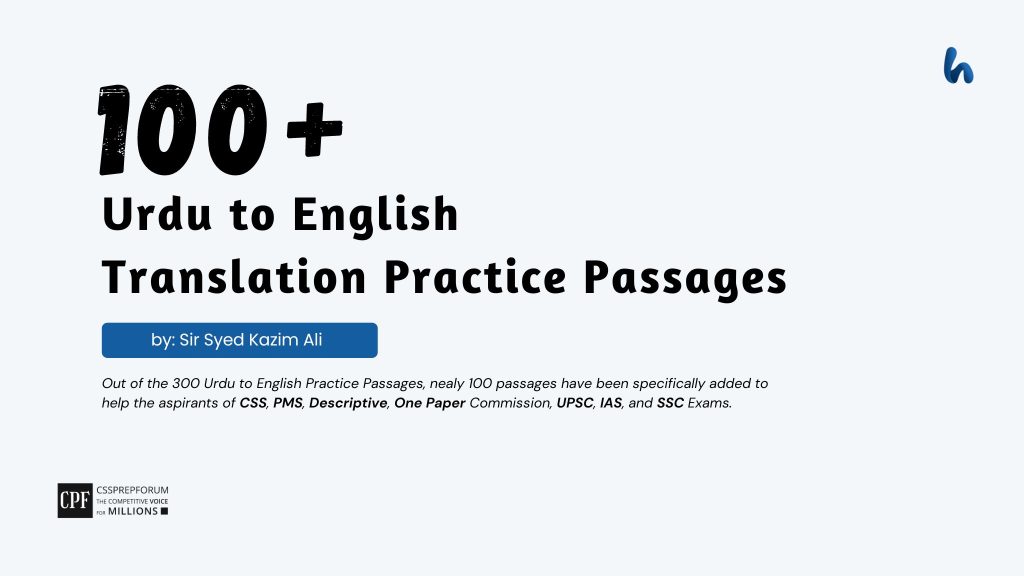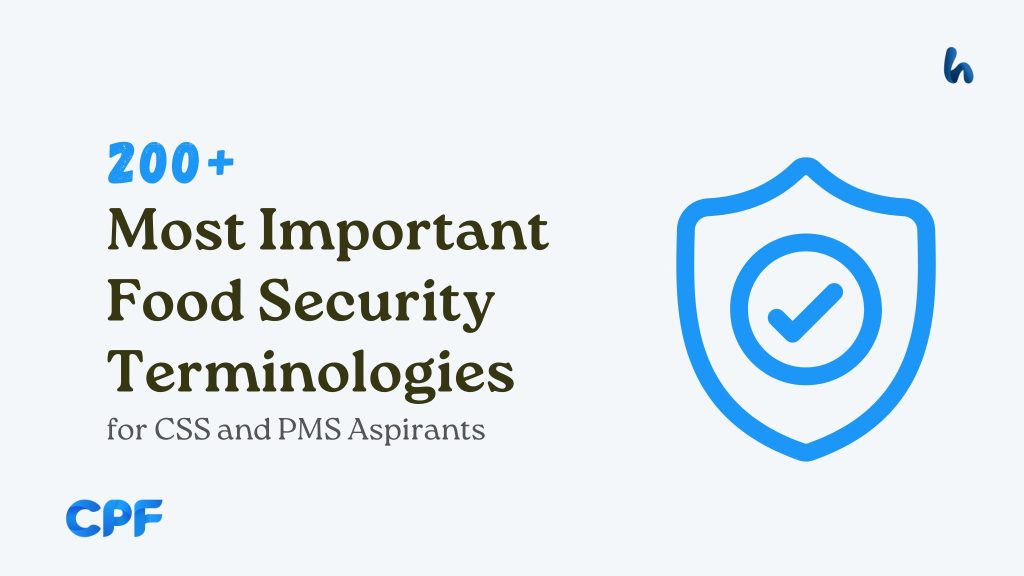This article comprehensively overviews the most important food security terminologies crucial for CSS and PMS aspirants. Learning to write them will enable aspirants to navigate complex political concepts effectively.

Learning to write subject terminologies is always essential for competitive exam students, especially CSS and PMS. This practice gives aspirants a deeper understanding of complex concepts, ultimately helping them articulate their thoughts clearly. Learning to write these terms appropriately not only enhances comprehension but also equips aspirants to engage effectively with exam essays. For example, in fields like political economy, acquaintance with terms such as “globalization” and “trade barriers” helps aspirants confidently analyze and debate relevant issues. After learning these terminologies, aspirants can tackle exam questions more adeptly because they can apply these terms contextually, demonstrating their knowledge and critical thinking skills. Therefore, learning subject-specific terminology is not just about learning words or vocabulary; it’s all about improving exam scores.
I have compiled the following terminologies from various reputable sources: dictionaries, websites, books, and magazines. This compilation is intended to aid my students in enhancing their vocabulary and effectively articulating their thoughts in essays, whether for compulsory or optional subjects.
Important Food Security Terminologies
| Food Security |
| Ensuring all people have access to sufficient, safe, and nutritious food at all times to lead a healthy life. |
| Food Insecurity |
| The inability to access adequate food due to financial or other constraints. |
| Malnutrition |
| Poor nutritional status resulting from a lack of, or an imbalance in, nutrient intake. |
| Undernutrition |
| Insufficient intake of calories, protein, or micronutrients, leading to various health issues. |
| Overnutrition |
| Excessive consumption of calories, leading to obesity and related health problems. |
| Hunger |
| The physical sensation of needing food, often leading to malnutrition if prolonged. |
| Chronic Hunger |
| A long-term condition where individuals do not get enough food on a regular basis. |
| Acute Hunger |
| A short-term and severe condition often linked to crises like famine or war. |
| Famine |
| Extreme scarcity of food, typically caused by factors like drought, war, or economic failure. |
| Starvation |
| Severe lack of food intake over an extended period, leading to illness or death. |
| Food Availability |
| The presence of adequate food supplies within a region or country. |
| Food Access |
| The ability of individuals to obtain food, determined by income, prices, and market systems. |
| Food Utilization |
| The body’s ability to digest and use food for energy, growth, and health. |
| Food Stability |
| Consistent availability, access, and utilization of food over time, avoiding shocks or crises. |
| Nutritional Security |
| Ensuring not just enough food, but also a balanced diet with essential nutrients. |
| Sustainable Agriculture |
| Farming methods that protect the environment, public health, and animal welfare while producing food. |
| Agroecology |
| An ecological approach to agriculture that promotes biodiversity and sustainable farming practices. |
| Biodiversity |
| The variety of life in the world, essential for maintaining balanced ecosystems and food production. |
| Climate Change |
| Long-term changes in temperature and weather patterns, affecting crop production and food security. |
| Resilience |
| The ability of food systems to withstand and recover from shocks such as droughts, floods, or economic crises. |
| Food Sovereignty |
| The right of people to define their own food systems and policies, prioritizing local food production. |
| Agricultural Productivity |
| The efficiency of producing food from farmland and other resources. |
| Yield |
| The amount of food produced from a given area of land. |
| Crop Diversity |
| Growing different types of crops to ensure a varied food supply and environmental resilience. |
| Staple Foods |
| Basic food items consumed regularly in a diet, such as rice, wheat, and maize. |
| Cash Crops |
| Crops grown primarily for sale and profit, such as coffee or cotton, rather than local food consumption. |
| Food Systems |
| The processes and infrastructure involved in feeding a population, including production, processing, distribution, and consumption. |
| Supply Chain |
| The network of producers, suppliers, and distributors that move food from farm to table. |
| Food Sovereignty Movement |
| A movement advocating for local, sustainable food systems that protect the rights of farmers and consumers. |
| Genetically Modified Organisms (GMOs) |
| Plants or animals that have been genetically engineered for traits like pest resistance or increased yield. |
| Agroforestry |
| A land management system combining agriculture and forestry to create more sustainable food systems. |
| Food Subsidies |
| Financial assistance provided by governments to lower the cost of food for consumers or support farmers. |
| Food Aid |
| Assistance given to countries or regions facing food shortages, often in the form of direct food supply or financial aid. |
| World Food Programme (WFP) |
| A UN organization focused on providing food aid to combat hunger worldwide. |
| Food Banks |
| Non-profit organizations that distribute food to those in need. |
| Food Desert |
| An area with limited access to affordable and nutritious food. |
| Food Surplus |
| Excess food production that exceeds the needs of the population. |
| Food Waste |
| Edible food that is discarded at various stages of the food supply chain. |
| Zero Hunger |
| A UN Sustainable Development Goal (SDG) aimed at ending hunger and ensuring food security by 2030. |
| Agri-business |
| Commercial enterprises involved in the production, processing, and distribution of agricultural products. |
| Precision Agriculture |
| The use of technology to optimize crop yields and resource use in farming. |
| Food Policy |
| Government actions or regulations that affect food production, distribution, and consumption. |
| Agricultural Policy |
| Laws and regulations governing farming practices, aimed at ensuring food security and supporting farmers. |
| Urban Agriculture |
| The practice of growing food in urban areas, including community gardens and rooftop farming. |
| Rural Development |
| Policies and projects aimed at improving the economic and social conditions of rural areas, often linked to food security. |
| Food Price Volatility |
| Large and unpredictable changes in food prices that can destabilize access to food. |
| Food Safety |
| Ensuring that food is free from contaminants or harmful substances and is safe for consumption. |
| Food Quality |
| The characteristics of food that affect its nutritional value, taste, and safety. |
| Nutrition-sensitive Agriculture |
| Agricultural practices aimed at improving nutritional outcomes, not just food quantity. |
| Biofortification |
| The process of increasing the nutrient content of crops through biological processes like plant breeding. |
| Micronutrients |
| Essential vitamins and minerals required in small amounts for proper body function. |

| Livelihood Diversification |
| Expanding income-generating activities beyond farming to improve food security. |
| Erosion |
| The degradation of soil quality, reducing its ability to support crop growth. |
| Agro-biodiversity |
| The variety of plant and animal species used in agriculture, which supports resilient food systems. |
| Fertilizers |
| Chemical or organic substances added to soil to increase its fertility and promote plant growth. |
| Pesticides Chemicals used to protect crops from pests and diseases. |
| Aquaculture |
| The farming of fish, shellfish, and aquatic plants for food. |
| Post-harvest Loss |
| The loss of food between the time of harvest and when it reaches the consumer, often due to poor storage or transportation. |
| Irrigation |
| The artificial application of water to land to aid in the growth of crops. |
| Drip Irrigation |
| A water-efficient irrigation system where water is delivered directly to the roots of plants. |
| Sustainable Development |
| Economic development that meets the needs of the present without compromising future generations’ ability to meet their own needs. |
| Food Reserves |
| Stockpiles of food maintained by governments or organizations to ensure food security during crises. |
| Livestock |
| Domesticated animals raised for food, fiber, or labor. |
| Green Revolution |
| A period of agricultural transformation that increased food production through the use of new technologies, fertilizers, and high-yield crops. |
| Permaculture |
| A design system for sustainable agriculture that mimics natural ecosystems. |
| Food Justice |
| The movement advocating for fair access to food and challenging inequalities in the food system. |
| Fisheries |
| Areas where fish are harvested for commercial or subsistence purposes. |
| Food Trade |
| The exchange of food products across borders, impacting food availability and prices. |
| Water Scarcity |
| The lack of sufficient water resources to meet the needs of food production. |
| Land Degradation |
| The decline in land quality due to overuse, deforestation, or poor agricultural practices. |
| Food Import Dependency |
| Relying on imported food to meet a country’s needs, which can impact food security. |
| Vulnerability |
| The susceptibility of individuals, households, or communities to food insecurity due to external factors. |
| Buffer Stocks |
| Reserves of food or other commodities held to stabilize prices and ensure supply during shortages. |
| Hydroponics |
| Growing plants without soil, using mineral nutrient solutions in water. |
| Organic Farming |
| A method of farming without synthetic chemicals, focusing on sustainability and natural processes. |
| Composting |
| The process of decomposing organic material to create nutrient-rich soil for farming. |
| Food Loss |
| The reduction in edible food at the production or post-harvest stages. |
| Global Hunger Index (GHI) |
| A tool designed to measure and track hunger at global, regional, and national levels. |
| Self-sufficiency |
| The ability of a country to meet its own food needs without relying on imports. |
| Farmer Cooperatives |
| Groups of farmers who work together to increase production, share resources, and improve market access. |
| FAO (Food and Agriculture Organization) |
| A UN agency that leads international efforts to defeat hunger. |
| Sustainable Intensification |
| Increasing food production from existing farmland while minimizing environmental impact. |
| Agrochemical Use |
| The application of chemical products in agriculture, including pesticides |
| Food Systems Approach |
| This perspective looks at the interconnectedness of food production, processing, distribution, consumption, and waste, emphasizing the need for holistic solutions to food security challenges. |
| Local Food Movements |
| Initiatives that promote the consumption of locally produced food, supporting local economies and reducing the carbon footprint associated with food transportation. |
| Fair Trade |
| A movement aimed at ensuring equitable trade conditions for farmers, especially in developing countries, promoting sustainable practices and fair wages. |
| Food Policy Analysis |
| The evaluation of policies impacting food systems to assess their effectiveness in promoting food security and sustainability. |
| Hunger Index |
| A tool used to measure and compare the prevalence of hunger and undernutrition across countries, often influencing policy decisions. |
| Supply Chain Management |
| The strategic oversight of all aspects involved in food production and distribution to enhance efficiency and minimize waste. |
| Social Determinants of Health |
| Factors such as socioeconomic status, education, and access to healthcare that influence individual and community health, including food security. |
| Environmental Sustainability |
| Practices that ensure natural resources are used responsibly and preserved for future generations, directly affecting food production. |
| Rural-Urban Linkages |
| The connections between rural areas (where food is produced) and urban centers (where food is consumed), influencing food distribution and security. |
| Nutrition Education |
| Programs aimed at informing individuals about healthy eating practices and the importance of nutrition for overall health, supporting food security goals. |
| Crisis Response |
| Emergency measures taken to address food shortages during disasters, conflicts, or economic crises, including food distributions and aid. |
| Agricultural Extension Services |
| Support services provided to farmers, offering education and resources to improve agricultural practices and productivity. |
| Microfinance |
| Financial services targeted at small-scale farmers and food producers, helping them invest in their businesses and improve food security. |
| Food Traceability |
| The ability to track food products from farm to table, ensuring safety, quality, and accountability in the food supply chain. |
| Policy Coherence |
| The alignment of different policies (e.g., agricultural, health, and trade) to ensure they collectively support food security objectives. |
| Dietary Diversity |
| The variety of different foods consumed in a diet, which is crucial for meeting nutritional needs and promoting health. |
| Food Paradox |
| The situation where food is plentiful, yet people still experience hunger and food insecurity, often due to economic or social barriers. |
| Seasonal Food Security |
| The concept that food security can vary throughout the year, often influenced by harvest cycles and market availability. |
| Community Resilience |
| The ability of a community to prepare for, respond to, and recover from food insecurity and other challenges. |
| Agricultural Innovation |
| New technologies and practices aimed at improving crop yields, efficiency, and sustainability in food production. |
Click on Any to Start Reading



FAQs About Sir Syed Kazim Ali

CSS Solved Past Papers’ Essays
Looking for the last ten years of CSS and PMS Solved Essays and want to know how Sir Kazim’s students write and score the highest marks in the essays’ papers? Then, click on the CSS Solved Essays to start reading them.
CSS Solved Essays
CSS Solved General Science & Ability Past Papers
Want to read the last ten years’ General Science & Ability Solved Past Papers to learn how to attempt them and to score high? Let’s click on the link below to read them all freely. All past papers have been solved by Miss Iqra Ali & Dr Nishat Baloch, Pakistan’s top CSS GSA coach having the highest score of their students. General Science & Ability Solved Past Papers












